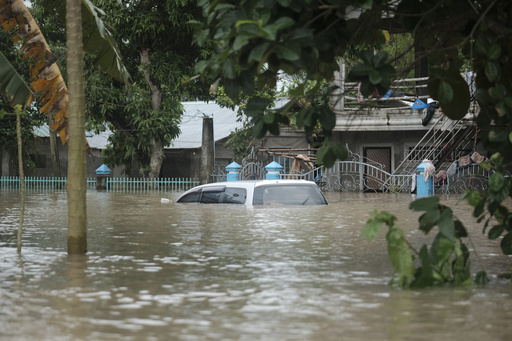
Tropical storm Trami has moved away from the northwestern Philippines, but its impact has been devastating, resulting in at least 46 fatalities due to severe flooding. This calamity has prompted officials to urgently gather additional rescue boats to assist thousands of individuals who found themselves stranded, with some requiring rescuers after climbing onto their rooftops.
As the storm began to clear, there are concerns that it could potentially alter its path and return next week, as it is influenced by high-pressure winds in the South China Sea. Trami is recorded to have last been located 125 kilometers (78 miles) west of the town of Bacnotan in La Union province, packing sustained winds up to 95 kilometers (59 miles) per hour with gusts reaching 115 kilometers (78 miles) per hour. It is currently projected to travel northwest toward Vietnam, expected to feel the storm’s effects as early as Sunday, provided it maintains its trajectory.
However, the Philippine weather agency has indicated the possibility of Trami turning back towards the Philippines due to weather dynamics. President Ferdinand Marcos raised this matter during an urgent assembly with his Cabinet and disaster management officials, expressing his concern over the forecast.
“Is it possible that it would return?” he inquired. A forecaster informed him that while a return towards the western part of the Philippines is a possibility early next week, it is more likely to veer away without making landfall. Nonetheless, Marcos highlighted the effect of Trami’s heavy rains, which can result in significant damage even without direct contact with the land.
In addition, Marcos pointed out another impending storm forming in the Pacific that could pose another threat to the nation. “Oh God, it is what it is. We just have to deal with it,” he remarked, reflecting on the situation.
State meteorologist Jofren Habaluyas shared that Trami’s unusual trajectory has caught the attention of meteorological experts across Asia, including Japan, which has been assisting the Philippines with storm tracking. The casualty count rose following more reports of deaths due to flooding and landslides, particularly in the Bicol region, a popular agricultural area home to the Mayon Volcano, which is known for its near-perfect cone shape.
Among the latest casualties, nine fatalities were from Batangas province, where heavy rainfall led to exceptional flooding. Local police reported that they are still compiling information regarding these incidents. Although Trami did not escalate into a typhoon, it unleashed unprecedented levels of rain in various regions, with some areas receiving what is typically a month’s worth of rainfall within just one day.
In the city of Naga, which recorded 11 drowning victims, and the surrounding provinces of Camarines Sur and Albay, authorities urgently requested additional rescue boats to assist those caught in the rising waters. In Albay province, the flow of mud and debris from the slopes of Mayon Volcano posed additional dangers, engulfing homes and vehicles in its path.
The recent flooding has affected over 2.6 million people, with nearly 320,000 seeking refuge in evacuation centers or with family members. In response to the crisis, the government has suspended classes and closed offices across the main island of Luzon, leading to the halt of inter-island ferry operations that have left thousands stranded.
In Vietnam, forecasters are warning of potential heavy rains in the central regions as they prepare for Trami’s possible impact. Prime Minister Pham Minh Chinh has instructed coastal provinces to remain alert, continuously tracking the storm’s movements and making preparations for potential disturbances.
The Philippines experiences roughly 20 storms and typhoons each year, with Typhoon Haiyan in 2013 being one of the most catastrophic, resulting in over 7,300 casualties and widespread destruction. Last month, Vietnam faced a devastating typhoon, Yagi, which resulted in 323 deaths and damage estimated at $3.3 billion, further highlighting the perilous nature of tropical storms in this region.
